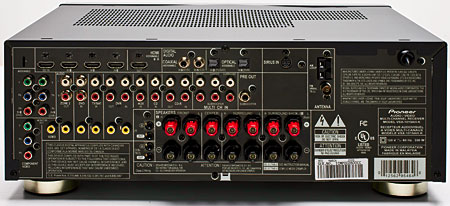Pioneer VSX-1019AH A/V Receiver
 Price: $500 At A Glance: Advanced feature set at budget price • Menu’s context-sensitive help offers timely advice • As listenable as budget receivers ever get
Price: $500 At A Glance: Advanced feature set at budget price • Menu’s context-sensitive help offers timely advice • As listenable as budget receivers ever get
The Cure for Feature Envy
The Pioneer VSX-1019AH has an exceptionally rich feature set at an affordable price. Its spec sheet is an epic document. But the feature that may matter most to a newbie would be the one that explains all the other features. I can sum it up in three self-explanatory words: context-sensitive help.

A/V receivers are notorious for giving up their secrets slowly and grudgingly. And the more features one has, the more torturous and drawn out the process becomes. What if you had a knowledgeable friend looking over your shoulder as you set up a receiver? The text-driven, context-sensitive help in this receiver is Pioneer’s equivalent of that knowledgeable friend. You can’t make a move in this AVR’s attractive new color user interface without your new friend explaining each item on the main menu.
System Setup lets you make the settings for the speakers, input terminals, etc. Click through to Manual Speaker Setup, which adjusts the various speaker-related items. Among them is an item that was unfamiliar even to me, X-curve. Pioneer’s Website says this is its take on a “living-room-sized version” of the ISO 2969 X-curve used in commercial cinemas. See www.HomeTheaterMag.com/glossary/ for a more thorough explanation of the original. According to the Manual Speaker Setup, if the treble seems too strong in a large room, the high-frequency response (2 kilohertz or greater) can be attenuated. Thus the surround virgin gets a precise description of a relatively arcane feature without having to leaf through the manual. This can be comforting.
Of course, the complete newbie will probably just run the auto setup program—in this case, Pioneer’s proprietary Multi-Channel Acoustic Calibration system (MCACC). As you become savvier, you may want to switch MCACC on and off to compare your system, with or without room correction. You may even want to use the manual nine-band onscreen graphic equalizer to hone in on certain acoustic problems—or just fool around. Each step of the way, your knowledgeable friend is there.
No Entry
Perhaps I’d better not call the VSX-1019AH an entry-level receiver. At $500, it’s actually the highest-priced of four new models in Pioneer’s regular (non-Elite) line, which also includes $400, $300, and $200 models.

Pioneer’s Website optimistically rates power at 120 watts times seven, but according to the manual, that’s with one channel driven. With a more conservative specification method, the number drops to 90, and as usual, HT Labs Measures (see next page) swoops in on the truth. No one in their right mind ever expects a budget receiver to drive power-pig speakers.
The front panel is pretty clean, with only 11 buttons, of which four are devoted to listening mode selection. A knob at the far left—every bit as large as the volume control at right—handles input selection. You have to cycle through the inputs to find the right one, but the big knob makes it fun, and it’s a lot easier than squinting for the right button with a flashlight in the dark. You can set the receiver to skip unused inpunailts, which will reduce the cycle to the necessary minimum.
- Log in or register to post comments




































































